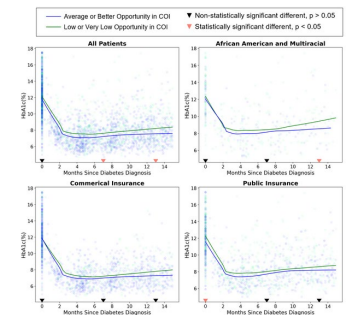Abstract: Associations Between the Child Opportunity Index 2.0 (COI) and Hemoglobin A1c (A1c) During the First Year Following a Diagnosis with Type 1 Diabetes (T1D)
B. Lockee1, E. Tallon1, C. Vandervelden1, K. Panfil1, M. Barnes1, D. Williams2, R. McDonough1, C. Schweisberger1, D. Maahs3, P. Prahalad3, D. Scheinker3, M. Clements1
1Children’s Mercy, Endocrinology, Kansas City, United States, 2Children’s Mercy, Kansas City, United States, 3Stanford University, Stanford, United States
Introduction: To provide patient-centered care to youth with T1D, clinicians must understand any social barriers to health
Objectives: We examined whether the COI is associated with A1c at onset and during the first year after T1D diagnosis
Methods: The COI is a measure of neighborhood opportunity across three domains: education, health and environment, and social and economic. We geocoded patient addresses and mapped them to census tracts.
We combined COI data from diversitydatakids.org with electronic health record data collected between 2018 and 2022 from a network of pediatric diabetes centers in the Midwest USA. Individuals were coded as living in a low opportunity area at diagnosis if the COI for their census tract was at the 40th percentile or lower (LO-COI; ≥41st percentile=HI-COI) for the metro area. We applied LOWESS smoothing to visualize trends across the population and key subgroups.
Results: We analyzed data for 784 unique individuals (age 9.9 ± 4.3, 46% female, 13% Black or multiracial [B/MR], 58% commercial insurance) with >2,900 A1c results. LOWESS curves for those in the LO-COI group are higher than those in the HI-COI group at nearly all points for each of the cohorts. We conducted two-sided t-tests for differences at three points for each population (onset, months 6-7, and months 12-13). A1c was higher in the LO-COI group at months 6-7 [7.9% LO-COI vs. 7.3% HI-COI, p<0.05]

Conclusions: During the first year after T1D diagnosis, mean A1c was higher in youths living in a low opportunity neighborhood, as well as in minority youths and those on public insurance. COI may help clinicians identify individuals at risk for worsening glycemia post-diagnosis and may identify those patients and families experiencing unique barriers to care.
Link: https://www.react-profile.org/upload/KIT/system/uploads/ISPAD2023_Abstracts.pdf